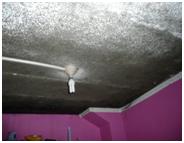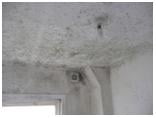A review of moulds and health issues
What are "moulds"?
Moulds are fungi. They are a group of plants that are unable to produce their own food. Moulds grow and develop by breaking down dead or decaying organic (carbon-containing) materials. What you see on typical mouldy walls or mouldy food are fungal spores, and other parts of fungal matter. It is the spores that enable the moulds to reproduce. You will also see mycelial fragments and “conidia” which is the name given to the structures on which the spores form.
Moulds in buildings nearly always result from persistent internal damp conditions and are often cited as a form of microbial pollution.
Moulds in houses usually belong to fungal groups called “Ascomycetes” or “Fungi imperfecti”. If you want to learn more about the biology, there are lots of good mycology websites to which you will be directed by any good internet search engine.
The conditions that support moulds to grow and develop
There are thousands of different species of moulds and they will grow and develop when the right conditions are present. Moulds are found everywhere, both indoors and outdoors, at all times of the year. Which species are present at any particular location and at any particular time will be determined by the conditions that are present.

These conditions are usually:
- a normal indoor temperature
- food, moisture and oxygen
- the right type of the surface (wallpaper, leather, plasterboard etc.)
In occupied buildings, therefore, the conditions for growth, for many types of mould, are present most, if not all of the time. Possible sources of indoor mould include the outside air, but also rotting food, potted plants, household food waste, as well as domestic pets. A large number of moulds that grow within buildings can also be found in normal garden soil.
How we measure the level of mould in buildings
When researchers publish figures about levels of mould spores present they usually are described as CFU/m3 (Colony Forming Units per cubic metre) rather than spores. This figure provides a better measure of the viability, or ability to grow and develop. There are usually higher levels of moulds outside than there are inside, so it’s practically impossible to avoid coming into contact with them. Studies of the amount of mould spores within buildings have shown that we can expect to find levels of 100 – 10000 CFU per cubic metre of air within buildings at most times of the year.
How can we limit the growth of moulds in buildings?
Since conditions within buildings are normally suitable for the growth and development of moulds, the only practical limiting factor is usually the level of moisture. The moisture that supports growth may be surface moisture on building materials or moisture in the building structure. These may be due to building defects, leaks or flooding, or excessive internal humidity and condensation. Note that I draw a distinction between condensation and high humidity. In many instances, moulds can be present on a surface that has not achieved the actual dew point temperature, but the localised humidity at that point is sufficient for moulds to grow.
The amount of moisture available to support fungal growth is usually described in terms of “water activity” which is given as a figure between 0 and 1. (It’s not quite the same as, but can be likened to Relative Humidity – at a localised level. For example a water activity of 0.75 is like saying the localised RH is 75%).
Different moulds favour different levels of moisture. Some require very high levels of available moisture (eg water activity of 0.95 and above), whereas others require lower levels (eg water activity of 0.70). Most moulds will grow at some level in between, and none at all will grow at a water activity below 0.60. The levels of available moisture are the most important single limiting factor of mould growth within buildings.
Monitoring the presence of moulds in building
There are a variety of methods that can be used to study and monitor the presence of moulds in the indoor environment. Many of these are used routinely within the food industries, where mould spoilage of food is a very serious problem. These include visual inspection, direct air sampling, and volumetric air sampling. Those interested in recommended sampling procedures should refer to the appropriate standards such as BS ISO 16000-19.

Moulds are not necessarily present as individual spores in the air, or as settled dust. They also can be present in the form of spore aggregates with lots of different species together, or in combination with lots of other moulds, household dust, material fibres and pollen.
Most mould spores are small; usually between 2 and 10 millionths of a metre in size. Some are a little bigger around 30 and a very few can be up to 100. The smaller ones are more easily airborne, and are readily blown around in the wind for example Pennicillium and Aspergillus. The larger ones are less easily blown around and are often found adhering to wet or slimy surfaces for example Fusarium and Stachybotrys-(the well-known toxic mould). The smaller ones are within the recognised “respirable range”, which means they can be readily inhaled into the bronchial passages and lungs.
The larger ones of which Stachybotrys (toxic mould) is an example, are less easily inhaled.
The most common moulds that are seen in buildings and the ones that are commonly found where there is condensation or persistent high humidity are within the following groups.
Pennicillium; Cladosporium; Alternaria; Chaetomium; Aspergillus; Trichoderma; Aurebasidium; Mucor
Note that in order to determine the exact species of each it would normally be necessary to grow them in culture in the laboratory before trying to identify them. They can be difficult to sort out and usually need, at least, a good transmitted light microscope, (1000*magnification) and a lot of experience, to identify them accurately.
Moulds and health problems
In houses, especially those that are damp for various reasons, moulds are a common problem. Amongst the moulds that are commonly found in houses there are a number that are known to be capable of producing metabolites that can be harmful to health. It’s important to remember that the spores themselves are not usually the only health hazard although they can cause allergic responses in sensitive individuals. When the spores settle on a surface that suits growth requirements they will grow and develop. During the process of growth and development, some moulds will release into the surrounding environment, metabolites that are harmful. These are often called volatile organic compounds (VOCs), or microbially-produced volatile organic compounds (MVOCs).
In recent years there has been an increased concern and increased media attention about the health effects of moulds in buildings. There are numerous websites that purport to provide advice, usually with a commercial motive. These are largely ill-informed, and seek to frighten susceptible members of the public into making a purchase of some sort of product or service. However, there are certain health issues associated with mould in buildings. These must be recognised and appropriate steps taken to minimise or prevent mould proliferation.
Fungi in general, and moulds in particular, can cause health problems in three ways:
- Fungi can produce an actual infection of the host. This involves growth on or in the person or animal. It is quite uncommon for environmental moulds to produce severe disease unless an individual has very severe reduction in the function of the immune system. A common example of this sort of infection is athlete’s foot, contracted most commonly from the floors of sports and swimming facilities.
- Fungi can produce allergic reactions. This usually involves inhalation of mould spores or particles. This type of problem can occur whether or not the fungus is still alive. This is the most commonly reported incident. Some of the reactions to mould are thought to include an increase in severity amongst asthma patients.
- Fungi can produce toxins (poisons) that make people sick. Although some toxins can be inhaled, the toxin is most often introduced into the person or animal by ingestion of mould–contaminated foods. Some of the toxins are very powerful, and can result in death. Fungal contamination of foodstuffs is a subject that is well-researched and understood within the food industry. Health-threatening mycotoxins are produced by only a limited number of fungal species, and strenuous efforts are made within the food industry to ensure that this type of food contamination is prevented.
Moulds within houses do not pose the same level of risk as might be found within a food manufacturing facility, but it is important to understand what the risks to health are, and how they can be managed, if not prevented.
The most commonly reported health problem associated with moulds is an allergic response in susceptible individuals. This reaction can also be brought about by pollen and household dust. Typical symptoms are wheezing, cough, rhinitis, itchy nose, sore throat, sinus congestion, and so forth. Dead fungi are able to produce symptoms just as well as live fungi. Thus, elimination of this form of health reaction requires reduction in the amount of fungi and other particulate matter in the environment, not just disinfection of the environment.
Moulds also synthesise a variety of volatile organic compounds (VOCs) that appear to be responsible for both the smell we associate with some fungal infestations along with (perhaps) some of the complaints associated with the presence of indoor mould infestations. In addition, there are a large number of VOCs that are present within buildings that do not come from moulds. For example, traffic pollution, smoke, cooking volatiles and volatiles that are emitted from constructional materials.
The ways in which VOCs contribute to human health issues is currently poorly understood. There are many studies within the literature that report an association between moulds and poor health. Whilst there is consistency in the findings of an association, or statistical correlation between dampness mould and illness, the cause (or causes) remain(s) elusive.Many of the earlier studies relied on self-reported information from the occupants of damp-affected houses, and such studies have been criticised for the inherent “reporting bias”. More objective studies have been carried out which have demonstrated that within asthma patients, those who displayed the severest symptoms also lived in the worst (dampness-affected) houses.
As things stand at present it is important not to underestimate the potential adverse health effects of moulds, but at the same time not to adopt an approach that exaggerates the problem. Moulds are and can be a problem when they are present, and further health problems can be generated by the emissions they produce (both volatile and non-volatile) when they grow and develop.
In the current climate of energy cost increases and political initiatives that are directed towards reducing carbon emissions, it is likely that these will result in lower internal temperatures and higher internal humidities. This is a combination that will result in an increase in mould growth.
The current advice we provide should be in line with the 2009 World Health Organisation report who say:-
“Management of moisture requires proper control of temperature and ventilation to avoid excess humidity, condensation on surfaces and excess moisture in materials. Ventilation should be distributed effectively throughout spaces, and stagnant air zones should be avoided.”
“Building owners are responsible for providing a healthy workplace or living environment that is free of excess moisture and mould, by ensuring proper building construction and maintenance. The occupants are responsible for managing the use of water, heating, ventilation and appliances in a manner that does not lead to dampness and mould growth.”
Those interested in this document, and the vast sources of information that are cited within, may download it for free from HERE
Article written by George McGill.
George McGill
McGill Consultancy Ltd
35 Cleveden Rd
Glasgow G12 0PH
Tel: 07766 704899
www.mcgill-consultancy.co.uk